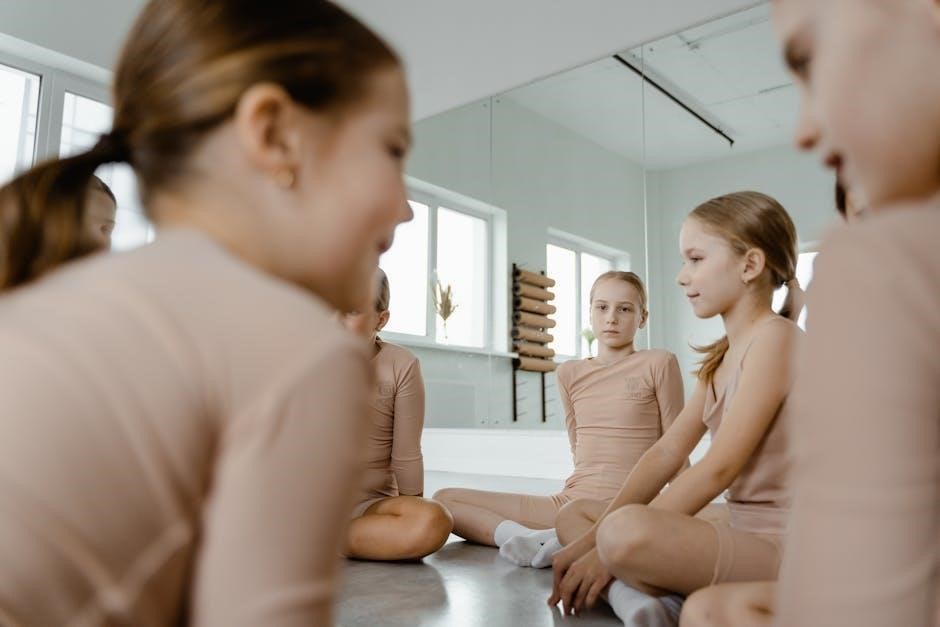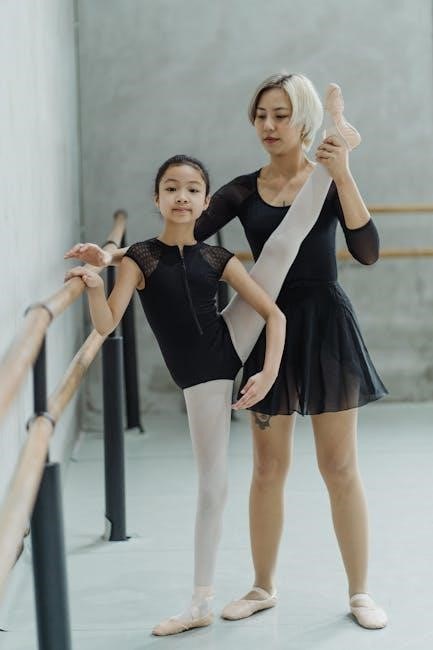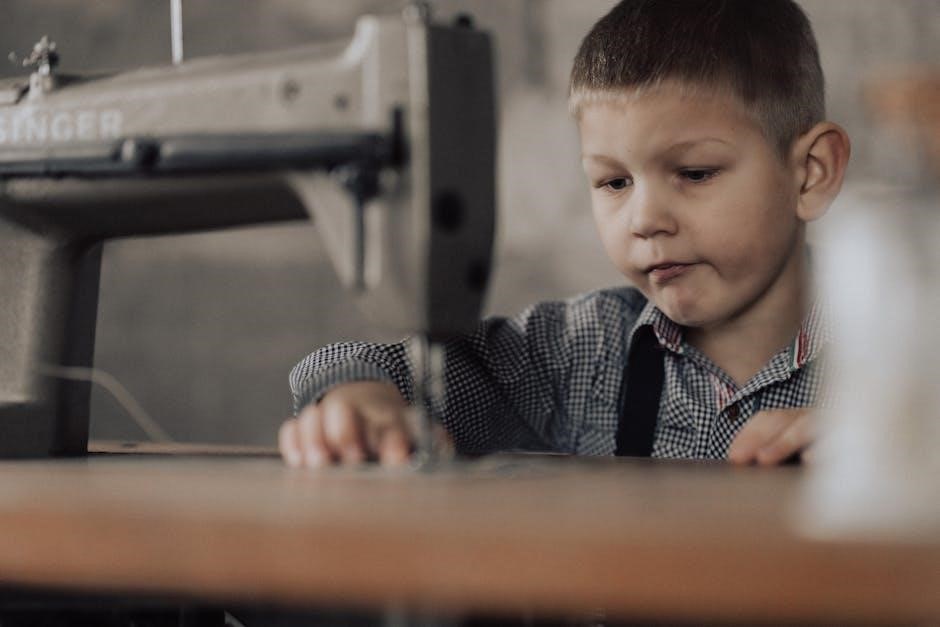Welcome to the beginner sewing class curriculum, designed to guide new sewists through foundational skills and creative projects. This comprehensive guide covers essential tools, techniques, and step-by-step projects, helping learners build confidence and mastery in sewing through hands-on practice and creativity.
1.1 Overview of Sewing Basics
Sewing basics form the foundation for every beginner, introducing essential tools, terminology, and techniques. This section covers fundamental concepts such as understanding sewing machines, hand stitches, and fabric handling. Learners will explore basic operations like threading, bobbin management, and straight stitching, along with hand stitching practices on felt. The curriculum emphasizes safety, proper tool usage, and quality control, ensuring a solid starting point for creative projects. These skills are crucial for building confidence and preparing students to tackle more complex tasks in subsequent lessons. By mastering these basics, beginners can progress smoothly through the curriculum and enjoy a fulfilling sewing experience.
1.2 Importance of Sewing Skills for Beginners
Acquiring sewing skills empowers beginners to create and repair garments, fostering sustainability and self-sufficiency. Sewing enhances problem-solving abilities and hand-eye coordination while providing a creative outlet. It allows individuals to personalize clothing, saving money and reducing waste. These skills also build confidence and patience, essential for tackling more complex projects. By mastering sewing, learners gain a valuable life skill that promotes independence and creativity, making it a rewarding hobby with practical applications. Encouraging beginners to embrace sewing fosters a sense of accomplishment and opens doors to endless creative possibilities, ensuring a lifelong appreciation for this timeless craft.
1.3 Structure of the Curriculum
The curriculum is thoughtfully structured to guide beginners from basic sewing concepts to practical applications. It begins with foundational skills like understanding tools and machine operations, followed by hand stitches and fabric basics. Each lesson builds on the previous one, ensuring a logical progression of learning. The curriculum is divided into weekly modules, allowing learners to master key techniques at a steady pace. Hands-on projects and step-by-step guides reinforce theoretical knowledge, while assessments and feedback provide opportunities for improvement. This structured approach ensures learners gain confidence and proficiency, preparing them for more advanced sewing challenges and creative endeavors.

Essential Sewing Skills for Beginners
Mastery of basic sewing tools, straight stitching, and hand stitches forms the core of foundational skills. Understanding fabric types, safety, and troubleshooting common mistakes ensures confidence and proficiency.
2.1 Understanding Sewing Tools and Equipment

Mastering sewing begins with identifying and understanding essential tools and equipment. Key items include sewing machines, scissors, pins, measuring tapes, seam rippers, irons, and cutting mats. Each tool serves a specific purpose, such as cutting fabric accurately or removing mistakes. Familiarizing yourself with the sewing machine’s parts, like the needle, bobbin, and presser foot, is crucial for smooth operation. Proper tool organization and maintenance ensure efficiency and safety. Consulting your machine’s manual and practicing with basic supplies will help you feel confident and prepared for sewing projects. This foundational knowledge is vital for building a strong sewing skill set.
2.2 Basic Sewing Terminology
Understanding basic sewing terminology is essential for effectively following patterns and instructions. Terms like “grain,” referring to fabric’s lengthwise and crosswise threads, and “selvage,” the fabric’s finished edges, are fundamental. Other key terms include “seam allowance,” the space between fabric edges, and “hem,” the folded edge of fabric. Familiarizing yourself with phrases like “right sides together” and “backstitch” aids in executing techniques correctly. Grasping this vocabulary ensures clear communication and avoids confusion, enabling you to complete projects with precision and confidence. This foundational language is crucial for progressing in sewing and understanding more complex techniques as you advance.
2.3 Safety Precautions in Sewing
Safety is paramount in sewing to prevent accidents and ensure a enjoyable experience. Always handle sharp tools like scissors, rotary cutters, and needles with care, keeping them out of children’s reach. Use protective gloves when handling sharp objects and eyewear when cutting or sewing. Avoid loose clothing that could get caught in the sewing machine. Keep the work area well-lit and clear of clutter to prevent tripping. Never sew near water or when fatigued. Store sewing machines and irons safely, away from heat sources. Proper ventilation is essential, especially when working with fabrics that produce fumes. Stay alert and follow manufacturer guidelines for all tools to maintain a safe sewing environment.

Sewing Machine Basics
Mastering sewing machine basics is crucial for beginners. Learn to identify parts, thread properly, and perform straight stitching. Modern machines offer ease of use and professional results.
3.1 Parts of a Sewing Machine
Understanding the parts of a sewing machine is essential for effective operation. Key components include the spool pin, bobbin, presser foot, and stitch selector. The manual provides detailed diagrams specific to your model, helping you identify and utilize each part correctly. Familiarizing yourself with these elements ensures smooth operation and troubleshooting. Modern machines may vary in features, but basic parts remain consistent, enabling you to sew efficiently and achieve professional results. This foundational knowledge is crucial for mastering sewing techniques and completing projects successfully.
3.2 Threading and Bobbin Management
Threading a sewing machine and managing the bobbin are critical skills for beginners. Start by correctly threading the machine, following the manufacturer’s guide, ensuring the thread passes through all designated guides. Proper tension is vital to prevent tangles or uneven stitching. The bobbin must be wound evenly, avoiding overfilling, and inserted correctly into the machine’s bobbin case. Always refer to your machine’s manual for specific instructions, as models may vary. Practicing threading and bobbin management ensures smooth sewing operations and helps avoid common issues like thread breakage or uneven stitches. Regularly check thread tension and bobbin alignment for optimal performance.
3.3 Straight Stitching and Basic Machine Operations
Mastering straight stitching is fundamental for beginners. Start with a straight stitch setting, using scrap fabric to practice even, consistent stitching. Focus on maintaining steady fabric movement and correct tension. Basic operations include starting and stopping smoothly, backstitching, and sewing straight lines. Practice on paper or simple fabric strips to build muscle memory. Understanding stitch length and width adjustments can enhance control. Regular practice helps develop precision and confidence in machine operation, forming the basis for more complex techniques. Always refer to your machine’s manual for specific guidance on settings and operations to ensure optimal results and minimize errors during practice sessions.

Hand Stitches for Beginners
Learn essential hand stitches like the running stitch, backstitch, and slipstitch. Practice on felt to create samples, focusing on even spacing and consistency to build foundational sewing skills effectively.
4.1 Common Hand Stitches
Mastering common hand stitches is vital for beginners. The running stitch, used for gathering or basting, is the simplest. The backstitch is ideal for sewing straight lines and outlining designs. The slipstitch is perfect for invisibly sewing seams or attaching facings. These stitches form the foundation of hand-sewing, allowing learners to create various projects confidently. Practicing these on felt or scrap fabric helps build precision and consistency, ensuring quality in every stitch. Understanding and mastering these techniques early on enhances overall sewing skills and prepares students for more complex projects in the curriculum.
4.2 Practicing Hand Stitches on Felt
Practicing hand stitches on felt is an excellent way for beginners to refine their skills. Felt’s thickness and stability make it ideal for creating clear, visible stitches. By using large needles and contrasting threads, learners can easily track their progress. Each stitch is demonstrated step-by-step, allowing students to replicate the techniques accurately. After practicing, students submit their work for grading, ensuring they meet quality standards. This hands-on approach builds confidence and muscle memory, preparing learners for more complex sewing tasks later in the curriculum.
4.3 Quality Control in Hand Stitching
Quality control in hand stitching ensures that each stitch meets consistency and precision standards. Students learn to inspect their work, checking for even spacing, tension, and proper technique. A grading rubric is used to assess each sample, focusing on accuracy and neatness. Feedback is provided to help learners improve, fostering a culture of attention to detail. By mastering these skills, students build a strong foundation for more advanced projects, ensuring their hand-stitched work is both functional and visually appealing.

Fabric Basics
Fabric basics introduce students to common materials like cotton, polyester, and blends, focusing on grain direction, texture, and proper cutting techniques to ensure accurate and professional results.
5.1 Types of Fabrics for Beginners
Beginners should start with easy-to-handle fabrics like cotton, polyester, and blends. Cotton is ideal for its stability and versatility, while polyester offers durability and a variety of textures. Blends combine the benefits of different fibers, making them easy to sew and care for. Knit fabrics, such as jersey, are perfect for stretchy projects like T-shirts, while linen is great for summer garments due to its breathability. Understanding these fabric types helps students choose the right material for their projects, ensuring successful outcomes and building confidence in fabric selection;
5.2 Understanding Fabric Grain and Texture
Fabric grain refers to the direction of the warp and weft threads in woven fabrics, which affects how the fabric behaves when cut and sewn. Properly aligning patterns with the grain ensures stability and prevents distortion. Texture describes the fabric’s surface quality, ranging from smooth (like cotton) to tactile (like velvet). Understanding grain and texture helps beginners choose the right fabric for their projects, ensuring stability and achieving the desired aesthetic. Recognizing these properties is essential for successful sewing, as they influence both the functionality and visual appeal of the finished garment.
5.3 Cutting Fabric Accurately
Cutting fabric accurately is a critical skill for beginners, ensuring proper fit and professional results. Essential tools include sharp scissors, rotary cutters, and mat, or dedicated sewing shears. Patterns guide fabric cutting, while rulers help measure and align edges. Always cut on a stable surface, iron fabric first to remove wrinkles, and follow grain lines for stability. Precision is key—misaligned cuts can lead to distorted seams. Beginners should practice cutting small fabric samples to build confidence. Avoid stretching fabric while cutting, as this can distort shapes. Accurate cutting lays the foundation for successful sewing projects, making it a skill worth mastering early.

Sewing Projects for Beginners
This section introduces simple sewing projects perfect for newcomers, starting with basic items like tote bags or pillowcases. These projects help build foundational sewing skills gradually.
6.1 Simple Sewing Projects
Simple sewing projects are perfect for beginners to build confidence and foundational skills. Start with easy tasks like creating a basic tote bag, pillowcase, or straight-line stitching on paper. Gradually move to small projects such as coin purses, fabric coasters, or drawstring bags. These exercises help develop essential techniques like fabric handling, straight stitching, and basic seam finishing. Each project is designed to introduce new skills progressively, ensuring a smooth learning curve. With clear, guided instructions and visual aids, learners can master these projects and troubleshoot common mistakes. Completing these tasks fosters a sense of accomplishment and prepares students for more complex sewing endeavors.
6.2 Step-by-Step Project Guides
Step-by-step project guides are essential for beginners, offering clear, detailed instructions for each task. Start with simple projects like sewing a straight line on paper or creating a basic tote bag. Each guide breaks down the process into manageable steps, ensuring learners understand fabric preparation, threading, and stitching techniques. Visual aids and diagrams complement written instructions, making complex tasks easier to follow. Troubleshooting tips are included to address common mistakes, such as uneven stitching or misaligned seams. These guides foster independence and confidence, allowing students to progress at their own pace while mastering foundational sewing skills. Practice and repetition reinforce learning, ensuring success in each project.
6.3 Troubleshooting Common Sewing Mistakes
Troubleshooting common sewing mistakes is crucial for improving skills and reducing frustration. Beginners often face issues like uneven stitching, misaligned seams, or fabric bunching. These challenges can be addressed by checking thread tension, ensuring proper fabric alignment, and using the correct stitch length. Mistakes in threading or bobbin management can cause machine malfunctions, such as skipped stitches or loose threads. By identifying these errors early and correcting them, students can produce professional-looking results. Instructors provide practical solutions and hands-on adjustments to help learners overcome these hurdles, fostering a smooth and enjoyable sewing experience.

Curriculum Structure and Lesson Plans
The curriculum is structured into weekly lessons, each with clear objectives, assignments, and feedback mechanisms to ensure steady progress and skill mastery for beginner sewists.
7.1 Weekly Lesson Breakdown
The weekly lesson breakdown organizes learning into manageable segments, ensuring steady progression. Each week focuses on specific skills, starting with machine basics, moving to fabric handling, and progressing to projects. Lessons include hands-on activities, demonstrations, and practice exercises. Assessments and feedback sessions are integrated to track improvement. This structured approach helps build confidence and ensures a comprehensive understanding of sewing fundamentals by the end of the course.
7.2 Assignments and Grading Criteria
Assignments are designed to reinforce learning and assess progress. Students complete practical tasks like creating hand stitch samples, sewing small projects, and finishing a final garment. Grading criteria include accuracy, completion, and adherence to instructions. Assignments are tailored to build skills progressively, ensuring mastery of techniques. Clear rubrics outline expectations for quality, creativity, and attention to detail. Feedback is provided to guide improvement. This structured approach ensures learners are fairly assessed and motivated to excel in their sewing journey.
7.3 Incorporating Feedback and Assessment
Feedback and assessment are integral to the curriculum, fostering growth and understanding. Instructors provide constructive feedback on assignments, highlighting strengths and areas for improvement. Regular assessments evaluate technical skills, creativity, and problem-solving abilities. Peer reviews encourage collaborative learning and mutual support. Students reflect on their progress, setting goals for further development. Feedback loops ensure continuous improvement, tailoring instruction to individual needs. This approach creates a supportive environment where learners can confidently refine their skills and achieve their sewing aspirations.

Advanced Techniques for Beginners
Expanding skills, this section introduces zippers, buttons, and curves. It also covers basic embellishments, helping beginners enhance their projects with confidence and creativity, building on foundational knowledge.
Mastering zippers and buttons is a key skill for beginners, allowing them to create functional and polished garments. This section teaches how to securely attach zippers and buttons, ensuring durability and a professional finish. Step-by-step guides help students practice these essential techniques, building confidence in handling various closures. Understanding the different types of zippers and buttons, along with the right tools needed, is emphasized. Hands-on exercises provide practical experience, enabling students to apply these skills to future projects seamlessly.
8.2 Sewing Curves and Corners
Sewing curves and corners is an essential skill for creating professional-looking garments and home decor items. This section focuses on techniques for navigating curved seams and sharp corners smoothly. Students learn how to pin and stabilize fabric to maintain shape and prevent distortion. Tips for sewing consistent, even stitches along curves and corners are provided, along with methods for pressing to achieve a crisp finish. Common challenges, such as puckering or unevenness, are addressed with practical solutions. Practice exercises help build confidence in handling intricate shapes, ensuring a polished result in every project.
8.3 Basic Embellishments and Decorations
Discover how to add personality to your sewing projects with basic embellishments and decorations. This section covers techniques like topstitching, embroidery, and appliqué, perfect for enhancing garments and home decor. Learn to work with buttons, ribbons, and other notions to create visual interest. Tips on proper placement and balance help ensure a professional finish; Practice exercises focus on mastering simple yet impactful decorative elements, allowing you to customize your creations and express your creativity. These skills not only elevate your projects but also build confidence in experimenting with texture, color, and design.

Resources and Materials
This section provides a comprehensive list of essential sewing tools, fabrics, and online resources for beginners. It helps students practice and improve their sewing skills effectively.
9.1 Recommended Sewing Tools and Supplies
To ensure a successful sewing experience, it’s essential to have the right tools and supplies. A reliable sewing machine, sharp scissors, assorted hand needles, and quality threads are must-haves. Measuring tapes, seam rippers, and fabric cutters are also crucial for accurate cutting and alterations. Ironing tools, like a steam iron and ironing board, help achieve professional finishes. Fabric markers and rulers aid in precise pattern tracing. For hand stitching, large needles and felt squares are ideal for practice. Optional tools include sergers for finishing seams and embroidery machines for decorative touches. Investing in durable, high-quality supplies ensures longevity and better results for beginner sewists.
9.2 Suggested Fabrics for Practice
When starting out, it’s best to practice with fabrics that are easy to handle and forgiving. Cotton, polyester blends, and linen are ideal for beginners due to their stability and ease of sewing. Rayon fabrics, while slightly more delicate, offer a soft drape, making them suitable for simple garments. Knit fabrics, like jersey, are great for practicing stretch stitches and creating comfortable projects. Avoid slippery fabrics like silk or heavily textured ones like velvet until more confidence is gained. Shopping at craft stores or online retailers provides access to a wide variety of affordable options. Using remnants or scrap fabrics for practice is both cost-effective and environmentally friendly.
9.3 Online Resources for Beginner Sewists
Online resources are invaluable for beginner sewists, offering tutorials, patterns, and communities. Websites like Craftsy and YouTube provide step-by-step video guides for learning various sewing techniques. Pinterest and sewing blogs showcase inspiration and tips for projects. Many platforms offer free sewing patterns and downloadable guides, perfect for practicing new skills. Additionally, online forums and social media groups connect sewists worldwide, fostering support and shared learning. These resources complement a structured curriculum, allowing learners to explore diverse methods and gain confidence in their abilities. Utilizing these tools enhances the learning experience and keeps beginners motivated as they progress in their sewing journey.
Mastering the basics empowers beginners to explore advanced techniques and creative projects confidently. Continuous practice and exploring online resources will further enhance their sewing skills and passion for the craft.
10.1 Review of Key Skills Learned
By the end of the curriculum, beginners will have mastered essential sewing skills, including machine operation, hand stitches, fabric handling, and project completion. These skills form a solid foundation for future sewing endeavors, enabling creativity and confidence in tackling various projects.
10.2 Encouraging Continued Practice
Consistent practice is key to improving sewing skills. Encourage students to set realistic goals, experiment with new fabrics, and explore different techniques. Suggest starting small projects like altering clothes or creating accessories to keep them engaged. Highlight the importance of patience and celebrating progress, no matter how small; Provide resources for further learning, such as online tutorials or sewing communities, to inspire continued growth. Emphasize that sewing is a lifelong skill, and mastery comes with time and dedication. Foster a love for the craft by making it enjoyable and rewarding at every stage.
10.3 Resources for Further Learning
To support continued growth, provide students with a list of recommended resources. Include books, online courses, and sewing communities for additional guidance. Highlight free online sewing courses and downloadable PDF guides that offer step-by-step instructions. Suggest joining sewing forums or social media groups to connect with fellow learners and share projects. Recommend websites like Craftsy or Pinterest for inspiration and tutorials. Encourage students to explore advanced techniques through YouTube channels or blogs dedicated to sewing. These resources will help learners stay motivated and expand their skills beyond the curriculum, fostering a lifelong passion for sewing.